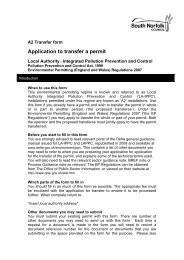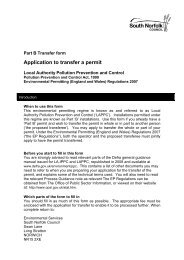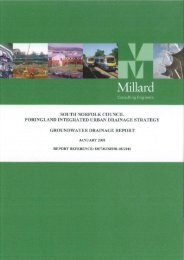have a look at this bee factsheet and see what best describes your ...
have a look at this bee factsheet and see what best describes your ...
have a look at this bee factsheet and see what best describes your ...
- No tags were found...
Create successful ePaper yourself
Turn your PDF publications into a flip-book with our unique Google optimized e-Paper software.
Bee inform<strong>at</strong>ion provided by the Norfolk Bee Keeping Associ<strong>at</strong>ionResponsibility for <strong>bee</strong> swarmsThe swarm is not the responsibility of the <strong>bee</strong>keeper. The swarm isthe responsibility of the person on whose property it has settled <strong>and</strong>remains so until it has <strong>bee</strong>n removed. In the event th<strong>at</strong> it cannotsafely be removed then the owner of the property must decide onwh<strong>at</strong> action he or she will take.Solitary BeesThese are sometimes referred to as mining <strong>bee</strong>s as they make small holes in the soft mortarjoints in brickwork. Holes in airbrick's, <strong>and</strong> the ends of garden canes, are also used by the<strong>bee</strong>s for egg laying.They <strong>look</strong> like honey <strong>bee</strong>s but are sometimes slightly larger <strong>and</strong> slower in their movements.They can appear in April when the we<strong>at</strong>her warms up <strong>and</strong> the eggs, which are laid theprevious spring, h<strong>at</strong>ch <strong>and</strong> adult <strong>bee</strong>s appear. The adults usually survive about 6-8 weeks<strong>and</strong> during <strong>this</strong> time they m<strong>at</strong>e <strong>and</strong>, in the holes from which they <strong>have</strong> emerged, lay the eggsfor next years <strong>bee</strong>s.Most do not sting <strong>and</strong> any th<strong>at</strong> could do not because the sting is normally too weak topenetr<strong>at</strong>e the human skin. Left alone they will not usually cause any harm. The numbersappearing <strong>at</strong> any one time is about 20/50 <strong>and</strong> unlike the honey <strong>bee</strong> they do not swarm.It is almost impossible to remove them <strong>and</strong> it is illegal to poison them. To try <strong>and</strong> stop themreappearing next year, the holes could be blocked with new mortar or some type of builder'ssealant. It is unwise to block airbricks as they are there for a purpose <strong>and</strong> should be left open.They are useful as pollin<strong>at</strong>ors, so will be <strong>see</strong>n working on flowers along with the honey <strong>bee</strong>.Bumble <strong>bee</strong>sThese are easy to identify with their round black furry bodies <strong>and</strong>football jersey liked stripes of either: yellow, orange or rustycoloured.The "Queen" emerges from hibern<strong>at</strong>ion in the spring <strong>and</strong> feeds onnectar <strong>and</strong> pollen. When the time is right she then searches out asite for the nest, <strong>this</strong> could be:disused mouse nests undergroundcompost heaps or bins (these are favourite places)unused bird nesting boxesunder garden sheds <strong>and</strong> other buildings (another favourite place)in wood pilesin thick tufts of grass.Once the site has <strong>bee</strong>n selected the queen then starts to lay eggs <strong>and</strong> from these come theyoung <strong>bee</strong>s, which are small to start with but grow quite quickly if sufficient food is available.A bumble <strong>bee</strong> nest usually never totals more than a few hundred <strong>bee</strong>s, often quite a lot less.



![List of outstanding appeals against planning decisions [PDF, 30 Kb]](https://img.yumpu.com/51294693/1/190x135/list-of-outstanding-appeals-against-planning-decisions-pdf-30-kb.jpg?quality=85)



![Brown bin calendar - week 2 [PDF] - South Norfolk Council](https://img.yumpu.com/49352110/1/184x260/brown-bin-calendar-week-2-pdf-south-norfolk-council.jpg?quality=85)



![Link magazine, Spring 2008 [PDF, 4,450k] - South Norfolk Council](https://img.yumpu.com/43994858/1/184x260/link-magazine-spring-2008-pdf-4450k-south-norfolk-council.jpg?quality=85)

![South Norfolk Council Volunteering Opportunities [PDF]](https://img.yumpu.com/42079564/1/184x260/south-norfolk-council-volunteering-opportunities-pdf.jpg?quality=85)
![Tiffey Valley Guide [PDF, 1,450k] - South Norfolk Council](https://img.yumpu.com/41615145/1/124x260/tiffey-valley-guide-pdf-1450k-south-norfolk-council.jpg?quality=85)
![Queen's Diamond Jubilee Fund [PDF] - South Norfolk Council](https://img.yumpu.com/41088331/1/184x260/queens-diamond-jubilee-fund-pdf-south-norfolk-council.jpg?quality=85)
